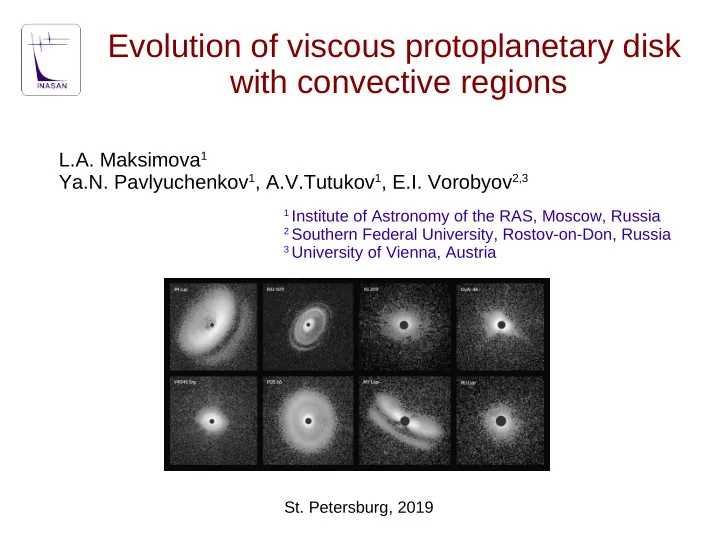

Evolution of viscous protoplanetary disk with convective regions L.A. Maksimova 1 Ya.N. Pavlyuchenkov 1 , A.V.Tutukov 1 , E.I. Vorobyov 2,3 1 Institute of Astronomy of the RAS, Moscow, Russia 2 Southern Federal University, Rostov-on-Don, Russia 3 University of Vienna, Austria St. Petersburg, 2019
General overview of star formation and yearly evolution of protoplanetary disk Prestellar phase Protostellar phase T Tauri phase The mechanisms of mass and angular momentum transfer in accretion disks are still under debate There are indications that disk accretion in protostellar and T Tauri phases is non-monotonic / episodic.
Episodic accretion scenario for yearly evolution of protoplanetary disks Proposed accretion rate history for a typical young star (Hartmann 1998) Luminosity evolution of FU Ori type objects Resolves the inconsistency between low accretion rates and short lifetimes of ptotoplanetary disks Explains the origin of FU Ori and EX Lupi Hartmann & Kenyon, ARAA (1996) type objects
Example: model of gravitationally unstable disk The luminosity outbursts are associated with fragments falling onto the star which are formed and migrating in gravitationally unstable disk The evolution of surface density distribution The calculated accretion rate in 2+1D model of protostellar disk Vorobyov & Basu, ApJ (2006) Vorobyov & Pavlyuchenkov, A&A (2017)
Is the convection an important process in protostellar disks?
Is the convection an important process in protostellar disks?
Our model The evolution of axially-symmetrical, geometrically thin, Keplerian disk without radial pressure gradients is prescribed by the Pringle equation (Pringle ARAA (1981)): where W is the infall rate of gas from envelope. The evolution of such disk is controlled by the radial profile of viscosity coefficient. In our model, it is given by: – background viscosity which provides continuous gas accretion – convective viscosity which depends on the convection parameters at given radius
Background viscosity is provided by some undefined mechanism (such as magneto-rotational or gravitational instability) We describe the background viscosity phenomenologically with the power law: where parameters and are selected to reproduce surface density profiles and accretion rates towards observed protoplanetary disks: Williams et al. A&A (2011) Hartmann et al. ApJ (1998)
The viscosity dissipation rate (per unit surface): The viscous heating in optically thick media can induce convective instability. Viscous and radiative heating for stationary accretion disk
Convective viscosity is non-zero in convectively unstable regions, it is introduced as: – the fraction of mass in convectively unstable region – disk height – velocity of convective elements (eddies) Velocity of convective eddies is found assuming that the whole viscous heating is transferred into kinetic energy of the gas:
The resulting distribution of convective viscosity is additionally smoothed over the radius using the Gaussian function of width H : The radial extent of convective region should not be smaller than the disk height!
Calculation of vertical disk structure UV heating and viscous heating Distributions of density and temperature in z-direction Diffusion of IR radiation Hydrostatic equilibrium Vorobyov & Pavlyuchenkov, A&A(2017)
Important element of the radiative transfer model is use of realistic dust opacities Temperature-dependent Frequency-dependent absorption Planck and Rosseland opacities and scattering coefficients Yellow bar is the temperature range where opacities are not appropriate due to the dust evaporation
Identification of convectively unstable regions Ratio of temperature gradient to adiabatic gradient as a function of z-coordinate for the flash phase Unstable layer Stable layer Convectively unstable region is shown with beige color
Infall rate from envelope onto disk (setup of W): in a ring 10 – 20 AU Estimation of the centrifugal radius for prestellar core L1544 Density profile: Centrifugal radius: Chacón-Tanarro et al. A&A(2019) Klapp et al. ApJ(2014)
Model results Evolution of surface density distribution The region of infall from envelope is shown with gray bar
The evolution of surface density and viscous heating rate distributions for several moments illustrating the development of the accretion outbreak Zero time corresponds to the end of the previous accretion outburst. Vertical bar shows the area of gas accretion from the envelope.
Radial distributions of accretion-decretion flux During outburst Before outburst The positive value of the flux (the upper part of each distribution) corresponds to the flow from the star, the negative value (the lower part of the distribution) corresponds to flow towards the star. The vertical bar shows the area of gas accretion from the envelope.
Development of convection in a disk is the process with positive feedback Increase of accretion flow Increase of viscous heating and temperature Gain of convective instability In our model, convection is self-sustaining only for short periods in the inner regions of the disk, while the role of background viscosity is important for ensuring its launch
The evolution of accretion rate and luminosity after establishment of a episodic accretion mode Accretion rate Accretion luminosity Thin red line corresponds to accretion luminosity of the entire disk. Thick blue line shows the luminosity which is associated with accretion of gas onto the star from the inner disk edge.
Variety of flaring young stellar objects Audard et al., PPVI (2014)
Scheme of the episodic accretion mode in a protoplanetary disk Outburst phase Accumulation phase
Conclusions 1. The presented model is rather illustrative because of the many underlying physical assumptions. Its main purpose is to demonstrate the possible role of convection as a driver of episodic accretion in protostellar disks. 2. There are a number of points which should be checked to verify the presented picture, such as: a) treatment of convective viscosity b) evaporation of dust above 1500 K c) dissociation and ionization of gas above 2000 K d) joint convective and radiative transfer 3. The presented picture need to be supported by more detailed hydrodynamic simulations.
Thank you Thank you for your attention for your attention
Recommend
More recommend